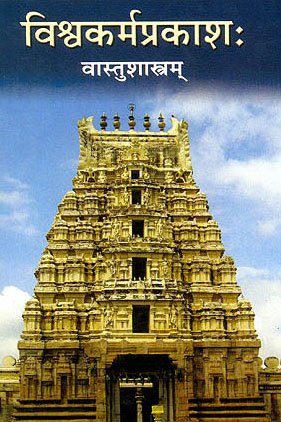Saubhagya, Saubhāgya, Saubhāgyā: 22 definitions
Introduction:
Saubhagya means something in Buddhism, Pali, Hinduism, Sanskrit, Jainism, Prakrit, Marathi, Hindi. If you want to know the exact meaning, history, etymology or English translation of this term then check out the descriptions on this page. Add your comment or reference to a book if you want to contribute to this summary article.
Alternative spellings of this word include Saubhagy.
In Hinduism
Vastushastra (architecture)
Source: Wisdom Library: Vāstu-śāstraSaubhāgya (सौभाग्य) refers to classification of a temple/buidling (prāsāda), according to Samarāṅgaṇasūtradhāra chapter 60. The temple is mentioned in a list of thirty-six Prāsādas having activities of the townsmen entailing Sādhārās. The Samarāṅgaṇasūtradhāra is an 11th-century encyclopedia dealing with various topics from the Vāstuśāstra.

Vastushastra (वास्तुशास्त्र, vāstuśāstra) refers to the ancient Indian science (shastra) of architecture (vastu), dealing with topics such architecture, sculpture, town-building, fort building and various other constructions. Vastu also deals with the philosophy of the architectural relation with the cosmic universe.
Purana and Itihasa (epic history)
Source: archive.org: Shiva Purana - English TranslationSaubhāgya (सौभाग्य) refers to “one who is fortunate”, according to the Śivapurāṇa 2.3.26 (“Pārvatī-Jaṭila dialogue”).—Accordingly, as Śiva (in guise of a Brahmacārin) said to Pārvatī: “[...] O gentle lady, are you the wife of an ascetic who does not provide you with food and shelter and so leaving you has gone to another place? Tell me, in which family are you born? Who is your father? What are your undertakings? You are very fortunate [i.e., mahā-saubhāgya-rūpā]. Futile is your interest in penance. Are you the mother of the Vedas? Are you Lakṣmī or Sarasvatī? I dare not guess who you are?”.
Source: Cologne Digital Sanskrit Dictionaries: The Purana IndexSaubhāgya (सौभाग्य).—When pralaya went up to the maharlokam and when the whole world was overwhelmed by ahaṅkāra there was a dispute between Brahmā and Kṛṣṇa when out of the latter's chest a light in the shape of a Linga came out. It was drunk by Dakṣa son of Brahmā and the result was the birth of Satī. The rest of rasa became eightfold, seven substances bringing fortune and salt.*
- * Matsya-purāṇa 60. 6-10.

The Purana (पुराण, purāṇas) refers to Sanskrit literature preserving ancient India’s vast cultural history, including historical legends, religious ceremonies, various arts and sciences. The eighteen mahapuranas total over 400,000 shlokas (metrical couplets) and date to at least several centuries BCE.
Shaktism (Shakta philosophy)
Source: Google Books: ManthanabhairavatantramSaubhāgya (सौभाग्य) refers to “good fortune”, according to the Śrīmatottara-tantra, an expansion of the Kubjikāmatatantra: the earliest popular and most authoritative Tantra of the Kubjikā cult.—Accordingly, “He who has the vidyā within (his) body by recollecting (it) attracts (towards himself) with the vidyā the supreme goal (of life), the best of women (parastrī) endowed with divine ornaments, the supreme nature, good fortune [i.e., saubhāgya], the supreme scripture, the supreme Command, the supreme knowledge, and the alchemical mercury”.

Shakta (शाक्त, śākta) or Shaktism (śāktism) represents a tradition of Hinduism where the Goddess (Devi) is revered and worshipped. Shakta literature includes a range of scriptures, including various Agamas and Tantras, although its roots may be traced back to the Vedas.
Jyotisha (astronomy and astrology)
Source: Google Books: Studies in the History of the Exact Sciences (Astronomy)Saubhāgya (सौभाग्य) refers to “good fortune”, according to the Ghaṭikāyantraghaṭanāvidhi, an unpublished manuscript describing the ritual connected with the setting up of the water clock and its invocation.—Accordingly, “[...] Now he tells the fruit of the rotation of the bowl, starting from the east etc., and ending in the middle. According as the bowl rotates in cardinal directions from the east up to the middle of the basin, it causes respectively the good fortune of having the husband alive and devoted (saubhāgya), death, near death of the bride (vadhūmṛtisama), the body full of diseases, the girl becomes the favourite [of all], resembles a courtesan, (?) virtuous, endowed wit h sons, wealth and relatives. Staying in the middle, [the bowl] grants noble [sons]. If the bowl becomes full (pūrṇā)[ and sinks] in the north, northeast, or in the east, it bestows auspiciousness; if it sinks (magnā) in the remaining directions, it is said to inflict widowhood on the girl”.

Jyotisha (ज्योतिष, jyotiṣa or jyotish) refers to ‘astronomy’ or “Vedic astrology” and represents the fifth of the six Vedangas (additional sciences to be studied along with the Vedas). Jyotisha concerns itself with the study and prediction of the movements of celestial bodies, in order to calculate the auspicious time for rituals and ceremonies.
Shaivism (Shaiva philosophy)
Source: SOAS University of London: Protective Rites in the Netra TantraSaubhāgya (सौभाग्य) refers to “(unequalled) prosperity”, according to the Netratantra of Kṣemarāja: a Śaiva text from the 9th century in which Śiva (Bhairava) teaches Pārvatī topics such as metaphysics, cosmology, and soteriology.—Accordingly, [verse 15.12-16ab, while describing the symbolic significance of mustard (seeds)]—“[...] Indeed, he should offer the highest red mustard together with black sesame sprinkled with three kinds of oils. Instantly, [this] produces the fruit of universal tranquility. Indeed, he should offer the highest red mustard together with black sesame sprinkled with three kinds of oils. Instantly, [this] produces the fruit of universal tranquility. If it is empowered by the [Mantrin] and placed in his hand, that person shall attain unequalled prosperity (saubhāgya—saubhāgyam atulaṃ tasya); there is no doubt. After [the Mantrin] chants the mantra over [the mustard seed] seven times, he should drop it on the head of [the beneficiary], who then is released from all faults”.

Shaiva (शैव, śaiva) or Shaivism (śaivism) represents a tradition of Hinduism worshiping Shiva as the supreme being. Closely related to Shaktism, Shaiva literature includes a range of scriptures, including Tantras, while the root of this tradition may be traced back to the ancient Vedas.
Sports, Arts and Entertainment (wordly enjoyments)
Source: archive.org: Syainika Sastra of Rudradeva with English Translation (art)Saubhāgya (सौभाग्य) refers to “she who is loved (by her husband)”, according to the Śyainika-śāstra: a Sanskrit treatise dealing with the divisions and benefits of Hunting and Hawking, written by Rājā Rudradeva (or Candradeva) in possibly the 13th century.—Accordingly, “[...] It has been said that there are eighteen addictions. These are the outcome of the desire for earthly enjovments. [...] Wise men speak of that wife as a wife who has auspicious marks and who knows the fine arts, who is clever, who is loved by her husband (saubhāgya-saṃyutā), and who is young and modest. She is the chief instrument in attaining the three objects of life, and she is the distinguishing feature of domestic life. She looks after the children and the utensils and other articles of the household, and she charms the mind. [...]”.

This section covers the skills and profiencies of the Kalas (“performing arts”) and Shastras (“sciences”) involving ancient Indian traditions of sports, games, arts, entertainment, love-making and other means of wordly enjoyments. Traditionally these topics were dealt with in Sanskrit treatises explaing the philosophy and the justification of enjoying the pleasures of the senses.
In Buddhism
Tibetan Buddhism (Vajrayana or tantric Buddhism)
Source: academia.edu: The Structure and Meanings of the Heruka MaṇḍalaSaubhāgyā (सौभाग्या) is the name of a Ḍākinī who, together with the Vīra (hero) named Saubhāgya forms one of the 36 pairs situated in the Jñānacakra, according to the 10th century Ḍākārṇava chapter 15. Accordingly, the jñānacakra refers to one of the three divisions of the saṃbhoga-puṭa (‘enjoyment layer’), situated in the Herukamaṇḍala. The 36 pairs of Ḍākinīs [viz., Saubhāgyā] and Vīras are white in color; the shapes of their faces are in accordance with their names; they have four arms; they hold a skull bowl, a skull staff, a small drum, and a knife.

Tibetan Buddhism includes schools such as Nyingma, Kadampa, Kagyu and Gelug. Their primary canon of literature is divided in two broad categories: The Kangyur, which consists of Buddha’s words, and the Tengyur, which includes commentaries from various sources. Esotericism and tantra techniques (vajrayāna) are collected indepently.
In Jainism
General definition (in Jainism)
Source: The University of Sydney: A study of the Twelve ReflectionsSaubhāgya (सौभाग्य) refers to “good fortune”, according to the 11th century Jñānārṇava, a treatise on Jain Yoga in roughly 2200 Sanskrit verses composed by Śubhacandra.—Accordingly, “Here in the world a whole multitude of objects, and the supremacy that is desired by the chiefs of snakes, men and gods, and other than [that], family, power, prosperity [com.—prosperity (subhagatvam) is good fortune (saubhāgyam)], and wanton women, etc. is easily obtained. On the contrary, that very same jewel of enlightenment alone is difficult to obtain. [Thus ends the reflection on] enlightenment”.
Synonyms: Subhagatva.
Source: academia.edu: Tessitori Collection ISaubhāgya (सौभाग्य) or “Saubhāgya Muni” is the author of the Ādijinastavana (dealing with classical hymns and stotras from Jain literature), which is included in the collection of manuscripts at the ‘Vincenzo Joppi’ library, collected by Luigi Pio Tessitori during his visit to Rajasthan between 1914 and 1919.

Jainism is an Indian religion of Dharma whose doctrine revolves around harmlessness (ahimsa) towards every living being. The two major branches (Digambara and Svetambara) of Jainism stimulate self-control (or, shramana, ‘self-reliance’) and spiritual development through a path of peace for the soul to progess to the ultimate goal.
Languages of India and abroad
Marathi-English dictionary
Source: DDSA: The Molesworth Marathi and English Dictionarysaubhāgya (सौभाग्य).—n (S subhaga) corruptly saubhāga n Good fortune or fortunateness; possession of favorable destinies. 2 The word is applied to anything considered as the cause, ground, seat, subject of good fortune, prosperity, excellence &c.--as learning, wisdom, rank, office, patronage of the great. 3 The happy and joyous state of wifehood, as opposed to widowhood; consisting in the privileges of using pigments, wearing ornaments &c.: also the auspiciousness, or excellent and blessed quality supposed to inhere in the husband-having dame. 4 The fourth of the twenty-seven yōga. 5 Minium or red lead. gaura rusalī sau0 ghēūna basalī (Amongst females.) Said of or to a sulky woman by one who disregards her humors and airs. sau0 miraviṇēṃ or lāvaṇēṃ To strut or act loftily; to play off conceits and high fancies; to give herself airs;--used of a (husband-having) woman. saubhāgyācā ṭikā The forehead-mark of a female indicating her happy state as married and unwidowed.
Source: DDSA: The Aryabhusan school dictionary, Marathi-Englishsaubhāgya (सौभाग्य).—n Good fortune; the happy and joyous state of wifehood.
Marathi is an Indo-European language having over 70 million native speakers people in (predominantly) Maharashtra India. Marathi, like many other Indo-Aryan languages, evolved from early forms of Prakrit, which itself is a subset of Sanskrit, one of the most ancient languages of the world.
Sanskrit dictionary
Source: DDSA: The practical Sanskrit-English dictionarySaubhāgya (सौभाग्य).—[subhagāyāḥ subhagasya vā bhāvaḥ ṣyañ dvipadavṛddhiḥ]
1) Good fortune or luck, fortunateness (chiefly consisting in a man's and woman's securing the favour and firm devotion of each other); प्रियेषु सौभाग्यफला हि चारुता (priyeṣu saubhāgyaphalā hi cārutā) Ku. 5.1; सौभाग्यं ते सुभग विरहावस्थया व्यञ्जयन्ती (saubhāgyaṃ te subhaga virahāvasthayā vyañjayantī) Meghadūta 29; (see Malli.'s remarks on saubhāgya in both places); युज्यत आत्मनः सौभाग्यं प्रच्छादयितुम् (yujyata ātmanaḥ saubhāgyaṃ pracchādayitum) V.2.
2) Blessedness, auspiciousness; समृद्धं सौभाग्यं सकलवसुधायाः किमपि तत् (samṛddhaṃ saubhāgyaṃ sakalavasudhāyāḥ kimapi tat) G. L.1.
3) Beauty, charm, grace; (yasya) हिमं न सौभाग्यविलोपि जातम् (himaṃ na saubhāgyavilopi jātam) Kumārasambhava 1.3;2.53;5.49; R.18.19; Uttararāmacarita 6.27.
4) Grandeur, sublimity.
5) The auspicious state of wifehood (opp. widowhood).
6) Congratulation; good wishes.
7) Affection, favour.
8) Red-lead.
9) Borax.
Derivable forms: saubhāgyam (सौभाग्यम्).
Source: Cologne Digital Sanskrit Dictionaries: Shabda-Sagara Sanskrit-English DictionarySaubhāgya (सौभाग्य).—n.
(-gyaṃ) 1. Auspiciousness, good fortune. 2. Blessednes. 3. Beauty, grace, charm. 4. Auspicious state of wife-hood, (as opposed to widow-hood.) 5. Congratulation. 6. The fourth of the astronomical Yogas. 7. Borax. 8. Red-lead. E. subhaga auspicious, ṣyañ aff.
Source: Cologne Digital Sanskrit Dictionaries: Benfey Sanskrit-English DictionarySaubhāgya (सौभाग्य).—i. e. su-bhaga + ya, n. 1. Good fortune, auspiciousness, [Meghadūta, (ed. Gildemeister.)] 30; [Nala] 1, 10; [Rājataraṅgiṇī] 5, 230; 282. 2. Beauty, charm, [Ṛtusaṃhāra] 6, 3; [Uttara Rāmacarita, 2. ed. Calc., 1862.] 155, 4. 3. Red lead.
Source: Cologne Digital Sanskrit Dictionaries: Cappeller Sanskrit-English DictionarySaubhāgya (सौभाग्य).—[neuter] = saubhaga.
Source: Cologne Digital Sanskrit Dictionaries: Monier-Williams Sanskrit-English Dictionary1) Saubhāgya (सौभाग्य):—[from saubhaga] a n. ([from] su-bhaga) welfare, good luck, good fortune, success, prosperity, happiness ([especially] conjugal felicity), [Ṛg-veda] etc. etc.
2) [v.s. ...] beauty, charm, grace, loveliness, [Mahābhārata; Rāmāyaṇa] etc.
3) [v.s. ...] affection, favour, [Monier-Williams’ Sanskrit-English Dictionary]
4) [v.s. ...] congratulation, good wishes, [ib.]
5) [v.s. ...] red lead, [cf. Lexicographers, esp. such as amarasiṃha, halāyudha, hemacandra, etc.]
6) [v.s. ...] borax, [cf. Lexicographers, esp. such as amarasiṃha, halāyudha, hemacandra, etc.]
7) [v.s. ...] a kind of plant, [cf. Lexicographers, esp. such as amarasiṃha, halāyudha, hemacandra, etc.]
8) [v.s. ...] the fourth of the astronomical, [Yoga-sūtra; cf. Lexicographers, esp. such as amarasiṃha, halāyudha, hemacandra, etc.]
9) b etc. See [column]2.
Source: Cologne Digital Sanskrit Dictionaries: Yates Sanskrit-English DictionarySaubhāgya (सौभाग्य):—(gyaṃ) 1. n. Auspiciousness, good fortune; 4th astronomical yoga; red lead.
Source: DDSA: Paia-sadda-mahannavo; a comprehensive Prakrit Hindi dictionary (S)Saubhāgya (सौभाग्य) in the Sanskrit language is related to the Prakrit word: Sohagga.
[Sanskrit to German]
Sanskrit, also spelled संस्कृतम् (saṃskṛtam), is an ancient language of India commonly seen as the grandmother of the Indo-European language family (even English!). Closely allied with Prakrit and Pali, Sanskrit is more exhaustive in both grammar and terms and has the most extensive collection of literature in the world, greatly surpassing its sister-languages Greek and Latin.
Hindi dictionary
Source: DDSA: A practical Hindi-English dictionarySaubhāgya (सौभाग्य) [Also spelled saubhagy]:—(nm) good luck, fortune; -[cihna] sign of a woman whose husband is alive (as [siṃdūra, mahāvara], etc.); ~[vatī] see [saubhāginī; ~vān] fortunate; ~[śālinī] see [saubhāginī], fortunate (fem.); ~[śālī] fortunate.
...
Kannada-English dictionary
Source: Alar: Kannada-English corpusSaubhāgya (ಸೌಭಾಗ್ಯ):—
1) [noun] that which is auspicious, causes or brings prosperity, welfare, etc.
2) [noun] good fortune; good luck.
3) [noun] the state of a woman whose husband is alive (as opp. to widowhood).
4) [noun] wealth; riches.
5) [noun] loveliness; comeliness; fairness; attractiveness.
6) [noun] a bright-red or slightly orange powder applied by women on their foreheads, as an auspicious sign and also used in worshipping a deity.
7) [noun] (yoga.) one of the twenty seven yogas.
8) [noun] (phil.) one of the forty kinds of qualities in the nature of things.
Kannada is a Dravidian language (as opposed to the Indo-European language family) mainly spoken in the southwestern region of India.
See also (Relevant definitions)
Starts with (+56): Saubhagya-ganapati, Saubhagyabhaskara, Saubhagyacandratapa, Saubhagyachandratapa, Saubhagyachihna, Saubhagyacihna, Saubhagyacinha, Saubhagyacintamani, Saubhagyadayin, Saubhagyadevata, Saubhagyadi, Saubhagyadravya, Saubhagyagauri, Saubhagyagaurivratavidhi, Saubhagyaghanta, Saubhagyahridaya, Saubhagyakalpadruma, Saubhagyakalpalata, Saubhagyakanda, Saubhagyakavaca.
Ends with: Akhandasaubhagya, Asaubhagya, Garbhasaubhagya, Gunasaubhagya, Hirasaubhagya, Janmasaubhagya, Mahasaubhagya, Svamisaubhagya.
Full-text (+84): Saubhagyadevata, Saubhagyavati, Saumangalya, Saubhagyavilopin, Saubhagyavayana, Saubhagyatritiya, Saubhagyacihna, Saubhagyatantu, Saubhagyavatta, Saubhagyatantra, Saubhagyavidya, Nishpava, Saubhagyavattva, Saubhagyalakshmyupanishad, Saubhagyalatikapaddhati, Dhanyaka, Saubhagyashunthi, Saubhagyakanda, Saubhagyabhaskara, Saubhagyashubhodaya.
Relevant text
Search found 41 books and stories containing Saubhagya, Saubhāgya, Saubhāgyā; (plurals include: Saubhagyas, Saubhāgyas, Saubhāgyās). You can also click to the full overview containing English textual excerpts. Below are direct links for the most relevant articles:
Sahitya-kaumudi by Baladeva Vidyabhushana (by Gaurapada Dāsa)
Text 7.38 < [Chapter 7 - Literary Faults]
Text 10.63 < [Chapter 10 - Ornaments of Meaning]
Text 10.265 < [Chapter 10 - Ornaments of Meaning]
Jnaneshwari (Bhavartha Dipika) (by Ramchandra Keshav Bhagwat)
Verse 16.16 < [Chapter 16 - Daivasura-sampad-vibhaga-yoga]
Verse 13.21 < [Chapter 13 - Kshetra and Kshetrajna Yoga]
Kamashastra Discourse (Life in Ancient India) (by Nidheesh Kannan B.)
8.2. Adornments and Caring of Body in Sahṛdayalīlā < [Chapter 5 - Looking for Alternatives: Possibilities in Kāmaśāstra]
Rig Veda (translation and commentary) (by H. H. Wilson)
Garga Samhita (English) (by Danavir Goswami)
Verse 2.16.36 < [Chapter 16 - The Worship of Tulasī]
Verse 2.16.2 < [Chapter 16 - The Worship of Tulasī]
Verse 2.15.38 < [Chapter 15 - Description of Śrī Rādhā-Kṛṣṇa’s Falling in Love]
The Skanda Purana (by G. V. Tagare)
Chapter 124 - Greatness of Saubhāgyeśvarī (Saubhāgya-īśvarī) < [Section 1 - Prabhāsa-kṣetra-māhātmya]
Chapter 61 - Saubhāgyeśvara (saubhāgya-īśvara-liṅga) < [Section 2 - Caturaśīti-liṅga-māhātmya]
Chapter 27 - Creating Agitation in Tripura < [Section 3 - Revā-khaṇḍa]